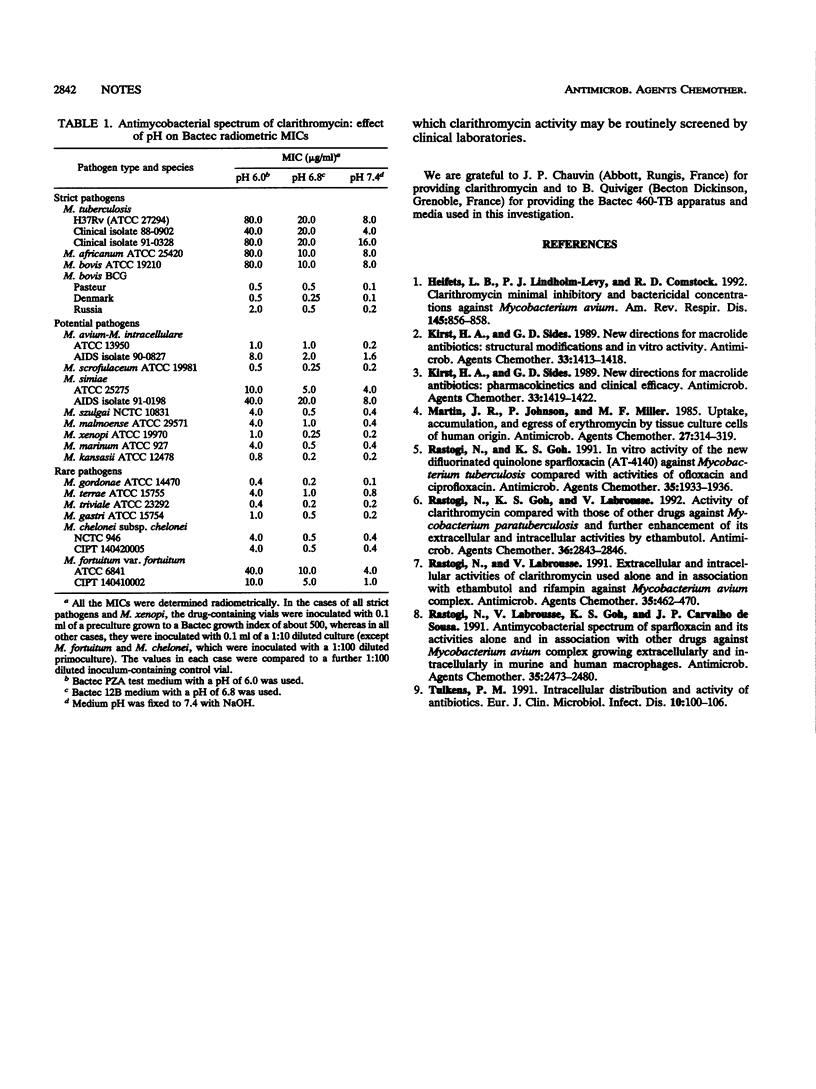Abstract
The antimycobacterial spectrum of clarithromycin, a new macrolide drug, was screened against 26 strains belonging to 18 species of mycobacteria by determining radiometric MICs by Bactec methodology at three different pHs, i.e., pH 6.0, 6.8, and 7.4. The MICs obtained at pH 7.4 were 1 to 2 or more dilutions lower in some of the species than those obtained at pH 6.8, whereas they were significantly higher at pH 6.0. The numbers of species for which MICs were below the Cmax levels of clarithromycin (i.e., 4 micrograms/ml) at different pHs were 8 of 18 species at pH 6.0, 13 of 18 species at pH 6.8, and 14 of 18 species at pH 7.4. The drug possessed promising activity against such potential pathogens as M. avium, M. scrofulaceum, M. szulgai, M. malmoense, M. xenopi, M. marinum, and M. kansasii and rare pathogens like M. chelonei.
Full text
PDF

Selected References
These references are in PubMed. This may not be the complete list of references from this article.
- Heifets L. B., Lindholm-Levy P. J., Comstock R. D. Clarithromycin minimal inhibitory and bactericidal concentrations against Mycobacterium avium. Am Rev Respir Dis. 1992 Apr;145(4 Pt 1):856–858. doi: 10.1164/ajrccm/145.4_Pt_1.856. [DOI] [PubMed] [Google Scholar]
- Kirst H. A., Sides G. D. New directions for macrolide antibiotics: pharmacokinetics and clinical efficacy. Antimicrob Agents Chemother. 1989 Sep;33(9):1419–1422. doi: 10.1128/aac.33.9.1419. [DOI] [PMC free article] [PubMed] [Google Scholar]
- Kirst H. A., Sides G. D. New directions for macrolide antibiotics: structural modifications and in vitro activity. Antimicrob Agents Chemother. 1989 Sep;33(9):1413–1418. doi: 10.1128/aac.33.9.1413. [DOI] [PMC free article] [PubMed] [Google Scholar]
- Martin J. R., Johnson P., Miller M. F. Uptake, accumulation, and egress of erythromycin by tissue culture cells of human origin. Antimicrob Agents Chemother. 1985 Mar;27(3):314–319. doi: 10.1128/aac.27.3.314. [DOI] [PMC free article] [PubMed] [Google Scholar]
- Rastogi N., Goh K. S. In vitro activity of the new difluorinated quinolone sparfloxacin (AT-4140) against Mycobacterium tuberculosis compared with activities of ofloxacin and ciprofloxacin. Antimicrob Agents Chemother. 1991 Sep;35(9):1933–1936. doi: 10.1128/aac.35.9.1933. [DOI] [PMC free article] [PubMed] [Google Scholar]
- Tulkens P. M. Intracellular distribution and activity of antibiotics. Eur J Clin Microbiol Infect Dis. 1991 Feb;10(2):100–106. doi: 10.1007/BF01964420. [DOI] [PubMed] [Google Scholar]


